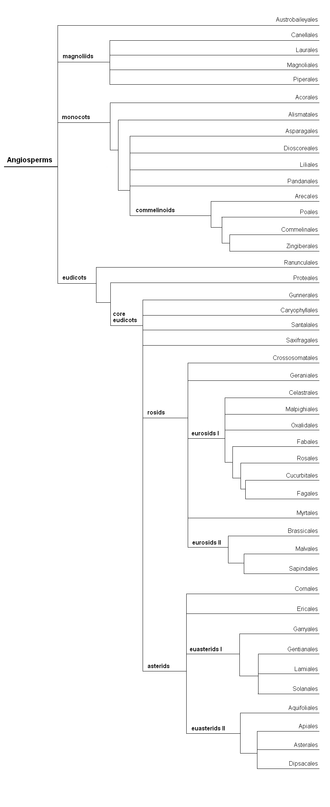bio.wikisort.org - Plant
The APG II system (Angiosperm Phylogeny Group II system) of plant classification is the second, now obsolete, version of a modern, mostly molecular-based, system of plant taxonomy that was published in April 2003 by the Angiosperm Phylogeny Group.[1] It was a revision of the first APG system, published in 1998, and was superseded in 2009 by a further revision, the APG III system.
History
APG II was published as:
- Angiosperm Phylogeny Group (2003). "An update of the Angiosperm Phylogeny Group classification for the orders and families of flowering plants: APG II". Botanical Journal of the Linnean Society 141(4): 399-436. (Available online: Abstract | Full text (HTML) | Full text (PDF) doi: 10.1046/j.1095-8339.2003.t01-1-00158.x)
Each of the APG systems represents the broad consensus of a number of systematic botanists, united in the APG, working at several institutions worldwide.
The APG II system recognized 45 orders, five more than the APG system. The new orders were Austrobaileyales, Canellales, Gunnerales, Celastrales, and Crossosomatales, all of which were families unplaced as to order, although contained in supra-ordinal clades, in the APG system. APG II recognized 457 families, five fewer than the APG system. Thirty-nine of the APG II families were not placed in any order, but 36 of the 39 were placed in a supra-ordinal clade within the angiosperms. Fifty-five of the families came to be known as "bracketed families". They were optional segregates of families that could be circumscribed in a larger sense.
The APG II system was influential and was adopted in whole or in part (sometimes with modifications) in a number of references. It was superseded 6½ years later by the APG III system, published in October 2009.
Groups

Main groups in the system (all unranked clades between the ranks of class and order):
- angiosperms :
- magnoliids
- monocots
- commelinids
- eudicots
- core eudicots
- rosids
- eurosids I
- eurosids II
- asterids
- euasterids I
- euasterids II
- rosids
- core eudicots
Shown below is the classification in full detail, except for the fifteen genera and three families that were unplaced in APG II. The unplaced taxa were listed at the end of the appendix in a section entitled "Taxa of Uncertain Position". Under some of the clades are listed the families that were placed incertae sedis in that clade. Thirty-six families were so placed. This means that their relationship to other members of the clade is not known.
- paraphyletic grade basal angiosperms
- family Amborellaceae
- family Chloranthaceae
- family Nymphaeaceae [+ family Cabombaceae]
- order Austrobaileyales
- order Ceratophyllales
- clade magnoliids
- order Canellales
- order Laurales
- order Magnoliales
- order Piperales
- clade monocots
- family Petrosaviaceae
- order Acorales
- order Alismatales
- order Asparagales
- order Dioscoreales
- order Liliales
- order Pandanales
- clade commelinids
- family Dasypogonaceae
- order Arecales
- order Commelinales
- order Poales
- order Zingiberales
- clade eudicots
- family Buxaceae [+ family Didymelaceae]
- family Sabiaceae
- family Trochodendraceae [+ family Tetracentraceae]
- order Proteales
- order Ranunculales
- clade core eudicots
- family Aextoxicaceae
- family Berberidopsidaceae
- family Dilleniaceae
- order Gunnerales
- order Caryophyllales
- order Santalales
- order Saxifragales
- clade rosids
- family Aphloiaceae
- family Geissolomataceae
- family Ixerbaceae
- family Picramniaceae
- family Strasburgeriaceae
- family Vitaceae
- order Crossosomatales
- order Geraniales
- order Myrtales
- clade eurosids I
- family Zygophyllaceae [+ family Krameriaceae]
- family Huaceae
- order Celastrales
- order Cucurbitales
- order Fabales
- order Fagales
- order Malpighiales
- order Oxalidales
- order Rosales
- clade eurosids II
- family Tapisciaceae
- order Brassicales
- order Malvales
- order Sapindales
- clade asterids
- order Cornales
- order Ericales
- clade euasterids I
- family Boraginaceae
- family Icacinaceae
- family Oncothecaceae
- family Vahliaceae
- order Garryales
- order Gentianales
- order Lamiales
- order Solanales
- clade euasterids II
- family Bruniaceae
- family Columelliaceae [+ family Desfontainiaceae]
- family Eremosynaceae
- family Escalloniaceae
- family Paracryphiaceae
- family Polyosmaceae
- family Sphenostemonaceae
- family Tribelaceae
- order Apiales
- order Aquifoliales
- order Asterales
- order Dipsacales
Note: "+ ..." = optionally separate family, that may be split off from the preceding family.
References
- Angiosperm Phylogeny Group (2003). An update of the Angiosperm Phylogeny Group classification for the orders and families of flowering plants: APG II. Botanical Journal of the Linnean Society 141(4): 399-436. doi: 10.1046/j.1095-8339.2003.t01-1-00158.x
Другой контент может иметь иную лицензию. Перед использованием материалов сайта WikiSort.org внимательно изучите правила лицензирования конкретных элементов наполнения сайта.
WikiSort.org - проект по пересортировке и дополнению контента Википедии